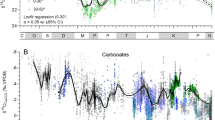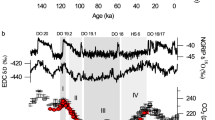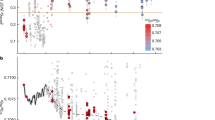Abstract
Interpretations of major climatic and biological events in Earth history are, in large part, derived from the stable carbon isotope records of carbonate rocks and sedimentary organic matter1,2. Neoproterozoic carbonate records contain unusual and large negative isotopic anomalies within long periods (10–100 million years) characterized by δ13C in carbonate (δ13Ccarb) enriched to more than +5 per mil. Classically, δ13Ccarb is interpreted as a metric of the relative fraction of carbon buried as organic matter in marine sediments2,3,4, which can be linked to oxygen accumulation through the stoichiometry of primary production3,5. If a change in the isotopic composition of marine dissolved inorganic carbon is responsible for these excursions, it is expected that records of δ13Ccarb and δ13C in organic carbon (δ13Corg) will covary, offset by the fractionation imparted by primary production5. The documentation of several Neoproterozoic δ13Ccarb excursions that are decoupled from δ13Corg, however, indicates that other mechanisms6,7,8 may account for these excursions. Here we present δ13C data from Mongolia, northwest Canada and Namibia that capture multiple large-amplitude (over 10 per mil) negative carbon isotope anomalies, and use these data in a new quantitative mixing model to examine the behaviour of the Neoproterozoic carbon cycle. We find that carbonate and organic carbon isotope data from Mongolia and Canada are tightly coupled through multiple δ13Ccarb excursions, quantitatively ruling out previously suggested alternative explanations, such as diagenesis7,8 or the presence and terminal oxidation of a large marine dissolved organic carbon reservoir6. Our data from Namibia, which do not record isotopic covariance, can be explained by simple mixing with a detrital flux of organic matter. We thus interpret δ13Ccarb anomalies as recording a primary perturbation to the surface carbon cycle. This interpretation requires the revisiting of models linking drastic isotope excursions to deep ocean oxygenation and the opening of environments capable of supporting animals9,10,11.
This is a preview of subscription content, access via your institution
Access options
Subscribe to this journal
Receive 51 print issues and online access
$199.00 per year
only $3.90 per issue
Buy this article
- Purchase on Springer Link
- Instant access to full article PDF
Prices may be subject to local taxes which are calculated during checkout



Similar content being viewed by others
References
Halverson, G. P., Wade, B. P., Hurtgen, M. T. & Barovich, K. M. Neoproterozoic chemostratigraphy. Precambr. Res. 182, 337–350 (2010)
Knoll, A. H., Hayes, J. M., Kaufman, A. J., Swett, K. & Lambert, I. B. Secular variation in carbon isotope ratios from upper Proterozoic successions of Svalbard and east Greenland. Nature 321, 832–838 (1986)
Des Marais, D. J., Strauss, H., Summons, R. E. & Hayes, J. M. Carbon isotope evidence for the stepwise oxidation of the Proterozoic environment. Nature 359, 605–609 (1992)
Kaufman, A. J., Knoll, A. H. & Narbonne, G. M. Isotopes, ice ages, and terminal Proterozoic earth history. Proc. Natl Acad. Sci. USA 94, 6600–6605 (1997)
Hayes, J. M., Strauss, H. & Kaufman, A. J. The abundance of C-13 in marine organic matter and isotopic fractionation in the global biogeochemical cycle of carbon during the past 800 Ma. Chem. Geol. 161, 103–125 (1999)
Rothman, D. H., Hayes, J. M. & Summons, R. E. Dynamics of the Neoproterozoic carbon cycle. Proc. Natl Acad. Sci. USA 100, 8124–8129 (2003)
Knauth, L. P. & Kennedy, M. J. The late Precambrian greening of the Earth. Nature 460, 728–732 (2009)
Derry, L. A. A burial diagenesis origin for the Ediacaran Shuram-Wonoka carbon isotope anomaly. Earth Planet. Sci. Lett. 294, 152–162 (2010)
Canfield, D. E., Poulton, S. W. & Narbonne, G. M. Late-Neoproterozoic deep-ocean oxygenation and the rise of animal life. Science 315, 92–95 (2007)
Fike, D. A., Grotzinger, J. P., Pratt, L. M. & Summons, R. E. Oxidation of the Ediacaran Ocean. Nature 444, 744–747 (2006)
McFadden, K. A. et al. Pulsed oxidation and biological evolution in the Ediacaran Doushantuo Formation. Proc. Natl Acad. Sci. USA 105, 3197–3202 (2008)
Grotzinger, J. P., Fike, D. A. & Fischer, W. W. Enigmatic origin of the largest-known carbon isotope excursion in Earth’s history. Nature Geosci. 4, 285–292 (2011)
Macdonald, F. A., Jones, D. S. & Schrag, D. P. Stratigraphic and tectonic implications of a new glacial diamictite-cap carbonate couplet in southwestern Mongolia. Geology 37, 123–126 (2009)
Halverson, G. P., Hoffman, P. F., Schrag, D. P., Maloof, A. C. & Rice, A. H. N. Toward a Neoproterozoic composite carbon-isotope record. Geol. Soc. Am. Bull. 117, 1181–1207 (2005)
McCay, G. A., Prave, A. R., Alsop, G. I. & Fallick, A. E. Glacial trinity: Neoproterozoic Earth history within the British-Irish Caledonides. Geology 34, 909–912 (2006)
McKirdy, D. M. et al. A chemostratigraphic overview of the late Cryogenian interglacial sequence in the Adelaide fold-thrust belt, South Australia. Precambr. Res. 106, 149–186 (2001)
Halverson, G. P., Hoffman, P. F., Schrag, D. P. & Kaufman, A. J. A major perturbation of the carbon cycle before the Ghaub glaciation (Neoproterozoic) in Namibia: prelude to snowball Earth? Geochem. Geophys. Geosyst. 3, 1035, http://dx.doi.org/10.1029/2001GC000244 (2002)
Hoffman, P. F., Kaufman, A. J., Halverson, G. P. & Schrag, D. P. A Neoproterozoic snowball earth. Science 281, 1342–1346 (1998)
Hoffmann, K. H., Condon, D. J., Bowring, S. A. & Crowley, J. L. U-Pb zircon date from the Neoproterozoic Ghaub Formation, Namibia: constraints on Marinoan glaciation. Geology 32, 817–820 (2004)
Macdonald, F. A. et al. Calibrating the Cryogenian. Science 327, 1241–1243 (2010)
Hoffman, P. F. & Schrag, D. P. The snowball Earth hypothesis: testing the limits of global change. Terra Nova 14, 129–155 (2002)
Swanson-Hysell, N. L. et al. Cryogenian glaciation and the onset of carbon-isotope decoupling. Science 328, 608–611 (2010)
Dehler, C. M. et al. High-resolution delta C-13 stratigraphy of the Chuar Group (ca. 770–742 Ma), Grand Canyon: implications for mid-Neoproterozoic climate change. Geol. Soc. Am. Bull. 117, 32–45 (2005)
Tziperman, E., Halevy, I., Johnston, D. T., Knoll, A. H. & Schrag, D. P. Biologically induced Snowball Earth. Proc. Natl Acad. Sci. 108 (37). 15091–15096 (2011)
Hayes, J. M. & Waldbauer, J. R. The carbon cycle and associated redox processes through time. Phil. Trans. R. Soc. B 361, 931–950 (2006)
Schrag, D. P., Berner, R. A., Hoffman, P. F. & Halverson, G. P. On the initiation of a snowball Earth. Geochem. Geophys. Geosyst. 3, 1036, http://dx.doi.org/10.1029/2001gc000219 (2002)
Halverson, G. P., Hoffman, P. F., Schrag, D. P. & Kaufman, A. J. A major perturbation of the carbon cycle before the Ghaub glaciation (Neoproterozoic) in Namibia: prelude to snowball Earth? Geochem. Geophys. Geosyst. 3, 1035, http://dx.doi.org/10.1029/2001gc000244 (2002)
Bjerrum, C. J. & Canfield, D. E. Towards a quantitative understanding of the late Neoproterozoic carbon cycle. Proc. Natl Acad. Sci. USA 108, 5542–5547 (2011)
Bristow, T. F. & Kennedy, M. J. Carbon isotope excursions and the oxidant budget of the Ediacaran atmosphere and ocean. Geology 36, 863–866 (2008)
Johnston, D. T. et al. An emerging picture of Neoproterozoic ocean chemistry: Insights from the Chuar Group, Grand Canyon, USA. Earth Planet. Sci. Lett. 290, 64–73 (2010)
Levashova, N. M. et al. The origin of the Baydaric microcontinent, Mongolia: constraints from paleomagnetism and geochronology. Tectonophysics 485, 306–320 (2010)
Acknowledgements
Laboratory assistance was provided by G. Eischeid, E. Northrop, E. Kennedy, T. O’Brien, A. Breus and A. Masterson. We thank G. Halverson, A. Bradley, E. Tziperman and P. Huybers for discussions and comments. We thank the Yukon Geological Survey, the NSF (grant number EAR-IF 0949227 to D.T.J.), KINSC (Haverford College), Henry and Wendy Breck (to D.P.S.), ESEP (Canadian Institute for Advanced Research, to P.F.H.), Harvard University and NASA NAI (D.T.J. and F.A.M.) for funding.
Author information
Authors and Affiliations
Contributions
This project was conceived by D.T.J., F.A.M. and D.P.S. Field work was conducted by F.A.M. and P.F.H. Carbonate carbon analyses were performed by F.A.M. Organic carbon analyses and modelling were carried out by D.T.J. and B.C.G. The paper was written by all authors.
Corresponding author
Ethics declarations
Competing interests
The authors declare no competing financial interests.
Supplementary information
Supplementary Information
This file contains Supplementary Text, Data, Methods and Materials, Supplementary Figures 1-8 with legends, Supplementary Table 1 and Supplementary References. (PDF 1673 kb)
Rights and permissions
About this article
Cite this article
Johnston, D., Macdonald, F., Gill, B. et al. Uncovering the Neoproterozoic carbon cycle. Nature 483, 320–323 (2012). https://doi.org/10.1038/nature10854
Received:
Accepted:
Published:
Issue Date:
DOI: https://doi.org/10.1038/nature10854
This article is cited by
-
Spatiotemporal variation of dissolved oxygen in the Ediacaran surface ocean and its implication for oceanic carbon cycling
Science China Earth Sciences (2023)
-
WANCE: A possibly Volcanism-Induced Ediacaran Carbon Isotope Excursion
Journal of Earth Science (2022)
-
Paired δ13Ccarb-δ13Corg Evolution of the Dengying Formation from Northeastern Guizhou and Implications for Stratigraphic Correlation and the Late Ediacaran Carbon Cycle
Journal of Earth Science (2020)
-
Chemostratigraphic correlations across the first major trilobite extinction and faunal turnovers between Laurentia and South China
Scientific Reports (2019)
-
A tectonically driven Ediacaran oxygenation event
Nature Communications (2019)
Comments
By submitting a comment you agree to abide by our Terms and Community Guidelines. If you find something abusive or that does not comply with our terms or guidelines please flag it as inappropriate.



